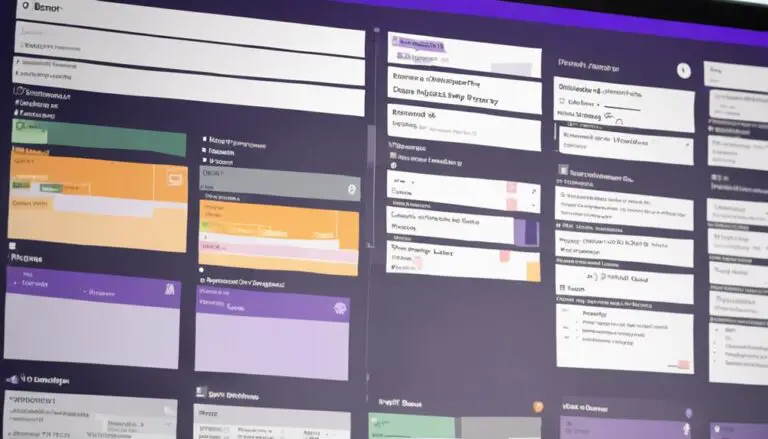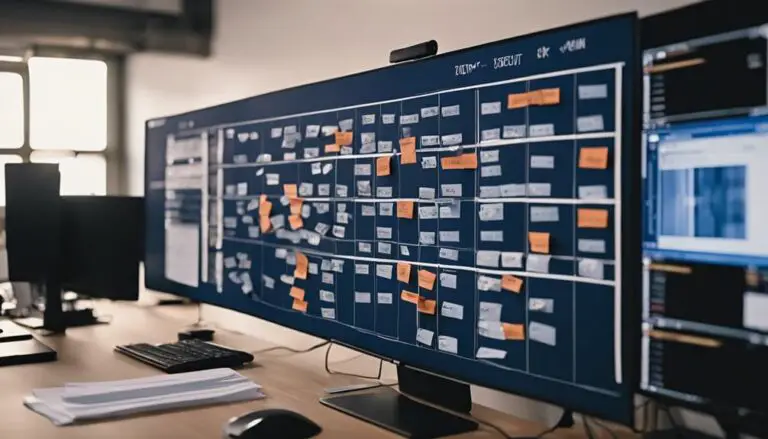You might think that daily stand-up meetings in Kanban are just a small part of the process, but you'll be surprised by the impact they can have on your team's productivity.
Discover how these short meetings can revolutionize the way your team works together and achieves its goals.
Key Takeaways
- Daily standups in Kanban foster team collaboration, accountability, and alignment.
- Effective standup meetings enhance transparency, efficiency, and issue resolution.
- Standups drive continuous improvement, workflow adjustments, and task coordination.
- Embracing Kanban principles improves workflow management, project delivery, and team dynamics.
Understanding the Role of Daily Standups in Kanban
To truly grasp the significance of daily stand-ups in Kanban, look beyond mere updates and focus on their pivotal role in fostering team collaboration and problem-solving.
Daily stand-up meetings serve as a cornerstone in the Kanban methodology, providing a platform for teams to come together in front of the Kanban board, share progress updates, and address any obstacles hindering workflow efficiency.
These brief 15-minute gatherings aren't just about reporting individual tasks but about collectively identifying and resolving issues visible on the Kanban board to ensure smoother processes and continuous improvement.
Best Practices for Conducting Daily Standups
Let's focus on enhancing your daily stand-ups with Kanban by considering the best practices.
Timing for standups, setting a clear agenda, and maintaining focus are key elements to keep in mind for productive meetings.
Encourage participation and engagement to ensure everyone is aligned and committed to addressing impediments effectively.
Timing for Standups
Starting your workday with a timely stand-up meeting sets the tone for progress and collaboration in implementing effective Kanban practices.
The best timing for Kanban stand-up meetings is typically at the beginning of the workday, allowing teams to align and focus on daily goals. Conducting stand-ups an hour after work hours can facilitate team alignment, ensuring everyone is on the same page.
Early morning stand-ups are beneficial as they help address potential blockers and plan for a productive day ahead. This daily practice not only promotes collaboration but also enables quick issue resolution and adjustments to optimize workflow efficiency.
Agenda and Focus
Align your team members' focus and set a clear agenda for your daily Kanban stand-up meetings by emphasizing concise updates and proactive issue resolution.
When structuring your stand-up meetings, consider the following:
- Quick Updates: Keep updates brief to save time and maintain focus on current tasks.
- Issue Resolution: Address any obstacles or bottlenecks visible on the Kanban board, encouraging collaborative problem-solving.
- Workflow Adjustments: Discuss potential workflow adjustments to streamline processes and improve overall efficiency.
Participation and Engagement
To enhance the effectiveness of your daily stand-up meetings, prioritize encouraging active participation and engagement from all team members. Engage the team by implementing strategies like rotating the speaking order to maintain involvement and gather diverse perspectives.
Utilize visual aids such as the Kanban board to enhance engagement and provide a clear focus for discussions during the stand-up. Foster a comfortable environment where team members feel encouraged to share updates and raise potential issues for effective participation.
Leverage the stand-up meeting as a platform for team members to openly showcase their contributions, progress, and challenges. By promoting active engagement within the team, you can create a collaborative atmosphere that maximizes the benefits of your stand-up meetings.
Implementing Effective Meeting Structures
To ensure effective meeting structures in Kanban, focus on managing meeting time efficiently, setting clear agendas, and fostering active participation among team members.
By managing time effectively, setting clear agendas, and encouraging active participation, you can enhance the productivity and value of your Kanban meetings.
Embrace these essential practices to streamline communication, problem-solving, and decision-making in your Kanban meetings.
Meeting Time Management
Enhancing meeting time management in Kanban involves structuring concise daily stand-up sessions to prioritize work progress and problem-solving discussions efficiently. When managing meeting time effectively in Kanban, consider the following:
- Keep it Short: Aim for around 15 minutes to ensure a quick and focused update session.
- Focus on Progress: Prioritize discussing items closest to completion on the Kanban board to keep the workflow moving.
- Utilize Techniques: Enhance meetings by incorporating strategies like walking the board and organizing separate discussions for detailed problem-solving.
Clear Agenda Setting
When structuring effective meeting structures in Kanban, ensure that the agenda is clearly defined to focus on progress updates and issue resolution.
Setting a clear agenda for daily Kanban stand-up meetings is crucial for keeping discussions on track and productive.
Make sure to include topics such as workflow adjustments and impediments visible on the Kanban board to address any issues promptly.
Prioritize solutions and enhancements to streamline processes and optimize workflow efficiency.
By implementing a structured agenda for your Kanban stand-up meetings, you can enhance communication, collaboration, and overall team productivity.
Encourage team members to actively participate in discussions surrounding agenda items to drive continuous improvement and foster a culture of shared responsibility.
Active Participation Encouragement
Encouraging active participation during Kanban stand-up meetings fosters a culture of collaboration and problem-solving among team members. To ensure all team members actively contribute and benefit from these meetings, consider the following:
- Create a Supportive Environment: Encourage open communication and idea sharing to maximize the value of daily stand-ups.
- Set Clear Expectations: Outline the purpose of the meeting and the importance of each team member's input for workflow improvement.
- Rotate Speaking Opportunities: Rotate who begins the updates or suggestions to promote equal participation and engagement among team members.
Overcoming Challenges in Daily Standups
Navigating through the daily stand-ups in Kanban can be a transformative journey in identifying and overcoming workflow challenges. During your daily Kanban meeting, team members gather to discuss impediments visible on the board, commenting on what's hindering progress. It's natural to encounter challenges in this process, but remember, you're not alone in this journey. Embrace these obstacles as opportunities for growth and improvement.
In these stand-ups, the focus is on addressing bottlenecks and ensuring smooth workflow processes. By openly discussing issues and collaborating on solutions, you pave the way for continuous improvement and efficient problem-solving. Effective daily stand-ups help keep teams focused, proactive, and aligned on project goals.
Embrace the challenges that arise during your daily stand-ups as chances to strengthen your team's bond and enhance productivity. Together, you can overcome these obstacles, foster a sense of belonging, and drive success in your Kanban workflow.
Strategies for Continuous Improvement
To enhance efficiency and foster a culture of continuous improvement, soliciting suggestions from your team members for workflow enhancements is a key strategy in Kanban. Embracing the principles of Kanban and Scrum, daily stand-up meetings serve as a platform for practical problem-solving and optimizing workflow.
Here are three effective strategies for continuous improvement in Kanban:
- Encourage Open Communication: Create a safe space during daily stand-ups for team members to share their ideas, feedback, and concerns openly. Emphasize the importance of continuous improvement and welcome suggestions for enhancing workflows.
- Implement Iterative Changes: Instead of waiting for major overhauls, focus on making small, incremental changes based on the feedback received from team members. This iterative approach allows for continuous adjustments that lead to significant improvements over time.
- Celebrate Progress: Acknowledge and celebrate the positive changes that result from the team's efforts towards continuous improvement. Recognizing achievements, no matter how small, motivates team members to remain committed to refining processes and achieving excellence in their work.
Enhancing Team Collaboration and Productivity
Transitioning from strategies for continuous improvement, fostering enhanced team collaboration and productivity in Kanban requires a focus on streamlined communication and shared accountability among team members during daily stand-up meetings. Daily stand-up meetings serve as a cornerstone for promoting team collaboration by providing a platform for quick updates on work progress and addressing any roadblocks that may hinder productivity. By encouraging open discussions about workflow adjustments and impediments, these meetings not only drive continuous improvement but also foster a culture of transparency and efficiency within the team.
Effective daily stand-ups in Kanban play a crucial role in keeping the team aligned and focused on project goals. By sharing individual progress, challenges, and achievements, team members can better understand each other's tasks and offer support where needed. This collaborative approach not only enhances productivity but also cultivates a sense of shared responsibility and camaraderie among team members. Embracing the principles of Kanban in daily stand-up meetings can lead to increased efficiency, improved communication, and ultimately, a more cohesive and productive team dynamic.
Frequently Asked Questions
Does Kanban Have Daily Standups?
In Kanban, daily check-ins aren't mandatory but serve as a tool for team collaboration and effective communication. They help kickstart your day, tackle obstacles, and fine-tune workflows. Embrace this practice for smoother operations.
Does Kanban Have Meetings?
In Kanban, meetings vary based on your team's needs. They enhance communication, collaboration, and decision-making. Choose the meeting frequency that suits your flow best, fostering a sense of unity and continuous improvement within your team.
What Is the Difference Between Daily Kanban and Scrum?
In Agile methodologies, Kanban vs Scrum differ in project management practices. Kanban focuses on flow and flexibility, while Scrum has set roles and ceremonies. Understanding these distinctions can help you adapt your approach effectively.
What Is the Difference Between Scrum Meetings and Kanban Meetings?
In Kanban vs Scrum, meeting dynamics differ. Scrum emphasizes team collaboration, focusing on tasks and people. Kanban emphasizes workflow efficiency, identifying bottlenecks, and improving processes. Both benefit from effective meetings tailored to their unique needs.
Conclusion
In conclusion, daily stand-up meetings are essential in Kanban for fostering collaboration, addressing issues, and improving workflow efficiency.
By implementing effective meeting structures and embracing continuous improvement strategies, teams can enhance productivity and overcome challenges.
For example, a software development team saw a significant increase in on-time project delivery and reduced bottlenecks by consistently discussing impediments and adjusting their workflow during daily stand-ups.
Keep up the good work and continue leveraging daily stand-ups to drive success in your Agile projects!





